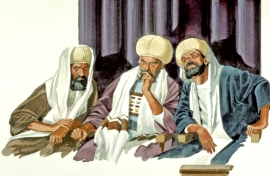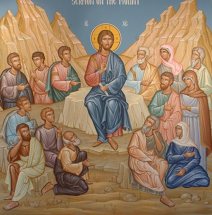Jesus Christ Crucified is Center
1 Corinthians 1:18-25 18 For the message of the cross is foolishness to those who are perishing, but to us who are being saved it is the power of God. 19 For it is written: “I will destroy the wisdom of the wise; the intelligence of the intelligent I will frustrate.” 20 Where is the wise man? Where is the scholar? Where is the philosopher of this age? Has not God made foolish the wisdom of the world? 21 For since in the wisdom of God the world through its wisdom did not know him, God was pleased through the foolishness of what was preached to save those who believe. 22 Jews demand miraculous signs and Greeks look for wisdom, 23 but we preach Christ crucified: a stumbling block to Jews and foolishness to Gentiles, 24 but to those whom God has called, both Jews and Greeks, Christ the power of God and the wisdom of God. 25 For the foolishness of God is wiser than man’s wisdom, and the weakness of God is stronger than man’s strength.
———————–
Without Jesus as Center, it is impossible to remain on the right path. It doesn’t matter the good intentions, rich history and traditions, well-meaning followers or leaders. Without Jesus as Center, the route traveled will quickly deviate off the appointed path to the right or to the left; even at some point spinning off to the degree of necessitating intervention.
This occurred in the Corinthian Church very early on and St. Paul’s “First Letter to the Corinthians” is his targeted attempt to repair it.

Corinth
A few years earlier, Paul came to Corinth and found a thriving commercial center; a hub of money, influence, thought, and immorality. Basically Corinth was a power-center much like a New York City or Los Angeles is today. And Paul, per his typical method, preached, evangelized, discipled, delegated, and then moved on to the next region to do the same; letting the newly placed local elders and leaders continue to shepherd, teach, and guide the newly converted Christians. This was the pattern.
There were problems with Corinth, however. Idolatries were very entrenched there and the new church became too influenced by its surrounding culture.
The result was twofold: A growing over-emphasis on human reason and on religious zealotry. Those two categorical issues were (and still continue to be) deadly in luring disciples away from experiencing the true life that Christ offers.
So reenter the Apostle Paul: Having heard about these concerns from afar, he sat down and penned this letter (1 Corinthians) to plead the message that Jesus Christ Crucified is the Center; anything else is foolishness and powerlessness!
1. The Foolishness of REASON
It might seem odd, at first glance, that the highly educated Apostle Paul would minimize the importance of human reason for he was known to persuade, debate, and engage the human mind in synagogues and in public squares alike. And we modern Westerners, children of the Enlightenment, might miss the gist of this text because when Paul quotes the Old Testament Prophet Isaiah (in vs.19) he is not suggesting a devaluation of truth. Instead, Paul is directly attacking the Greek philosophy that had so heavily influenced the Corinthian Church after his departure; it had been veering those new disciples away from Jesus as Center.
The Greek Philosophers taught that there was a dualism in life — The spirit being good and pure and the body/earth being impure or nonessential. Even as Paul was evangelizing, and later penning letters, this Greek philosophy was crystallizing more and more into an intense “Gnostic” strain (meaning “knowledge”). Scholars call this early appearance “proto-Gnosticism”, but I’ll simply refer to it as Gnosticism as it has changed so little at its core.
Those Gnostics argued much about all the latest ideas and perspectives but it was all “head” knowledge. There was deadness to all the philosophizing and opinionating about their points of view: All head but no heart.

Apostle Paul Writing
It was within this context that Paul admonished the (Gnostic-influenced) Corinthian Christians that they had gotten it backwards. All of the head-knowledge philosophizing and disputing was utter foolishness. Instead of arriving at Jesus as Center, all that speculative human reasoning ended up instead at themselves as center.
And so then it became anthropocentric, not christocentric; worthless and foolish. That word “foolish”, the Greek moraino, is the same used of the salt that became tasteless and worthless thereby needing to be tossed out (Mt 5:13, Lk 14:34) as well as the description of the idolatry of the Gentiles in Romans 1 who “claimed to be wise” (Rom 1:22) but who were really fools about spiritual truth.
Fast forward to today where the Gnostic error continues to hold sway. There are many current dialogues and conversations about how to “do life” and even “do church” according to the philosophies and progressive trends of the ever-changing culture, and there is also the inundation of the “principles for success” pragmatism as well, but these are not based on the centrality of Christ and Him crucified.
And let’s not miss the important point: The “crucified” adjective is crucial. In verse 23, Paul drives home this point, “but we preach Christ crucified” and then elaborates that this is where true wisdom originates.
Let’s be clear: Even though there can be layers of church, religion, and even Jesus placed on top to give an appearance of authenticity, it’s still NOT the gospel unless Christ Crucified is Center. All else is utter foolishness.
2. The Powerlessness of RELIGION
The other destructive fallacy contaminating the Corinthians was religious zealotry. In verse 22, Paul writes that the “Jews demand miraculous signs”. What Paul meant was that the Jews had elevated the importance of religious power, signs and miracles; in essence they were awaiting a Messiah who would fulfill their national hopes and accomplish their socio-political goals by ousting the Roman Empire in a show of power.
They wanted a Messiah to validate their self-centered interpretations, religious rites and traditions. So by interpreting the scriptures through the lens of their own religious traditions and culture, they had created a god in their own image, and thereby missed the real power of God in Christ.
For God’s true Messiah was not a commanding warrior for the Jews only but quite the opposite; a crucified suffering servant for ALL nations, in the vein of Isaiah 52-53.
To the Jews this concept was mind-blowingly offensive; much like if Osama Bin Laden’s head was carved onto Mt. Rushmore in the prominent place where George Washington’s head used to be. Unarguably offensive.
Case in point: The Apostle Paul himself. He describes his religious pedigree in Acts 22 as one thoroughly trained and zealous, persecuting Christians, even to the point of murder (Acts 8: The stoning of Stephen).

Religious Zealots Self-Righteously Judging and Imposing Rules
That the Messiah would be crucified (let alone worshiped as divine) was absolutely disgraceful to Paul (before his conversion) as well as to the Jewish people in general. This is because the Jewish religion held that anyone who was hung on a “tree” was accursed (Gal 1:13-14, 3:13) and they could not wrap their minds around the fact that the God-Man Jesus so loved his people that he went willingly to the accursed cross; dying a criminal’s death, paying the penalty for sin and brokenness, thereby redeeming mankind and creation.
This was a massive “stumbling block” as religious Jews could not get past the offensiveness of the cross. Here in verse 23 is the Greek scandalon where we get our word “scandal”. It was an indignity to religiously zealous people that they could not try harder, self-improve, do or be anything in order to become right in God’s eyes. The message of the cross was an absolute outrage!
In response, Paul is direct, using that word scandalon; echoing back to Jesus words in the gospel where our Lord accused Peter, “Get behind me, Satan! You are a stumbling block to me, for you are not setting your mind on God’s interests, but man’s” (Mt 16:23).
Within the Corinthian Church, those old religious beliefs and traditions were so insidiously formidable that they began to creep in and undercut the gospel. The religious zealots (much like the Judaizers of Galatians) were followers of Jesus within the church but they layered on top all the legalistic rules and self-righteousness from their traditions. But by doing so, by adding anything to Christ Crucified, they subtracted Him away. There cannot be Jesus Christ as Center plus any other stipulations or addendums. To do so deflates the power of the gospel.
A note about belief: The Greek word used in verse 21 for “belief”, pisteuo, carries a far weightier meaning than simple intellectual assent. To truly believe in Jesus Christ, in the scriptural sense, means to fully entrust and place confidence in him and his work on the cross on our behalf.
Fast forward to today where self-righteous religious zealotry (both fundamentalist AND progressivist) continue to be pervasive within the Christian community. Where religious rules, denominational (and non-denominational) traditions, and overwhelming focus on what they are doing (or not doing) continues to sweep away the grace of God infused into the centrality of Jesus Christ Crucified.
So, what does God think about all this?
God’s grace is revealed remarkably in verse 21 where the text reads that, “God was pleased through the foolishness of what was preached to save those who believe”. This word “pleased” (well-pleased), the Greek eudokeo, is the exact word God spoke to vocalize his complete delight in His Son Jesus at his Baptism (Mt 3/Mk1/Lk 3) and later at the Transfiguration (Mt/Mk/Lk 9).
Imagine that! The same pleasure and delight the Father has for his beloved Son is the exact same he has in saving to himself (through the message of his gospel; the cross) people adopted as His sons and daughters.
What might have appeared like foolishness to some or scandalous to others is exactly what we all need. The message of the gospel leads us directly to Jesus Christ Crucified as Center.
#Wade









